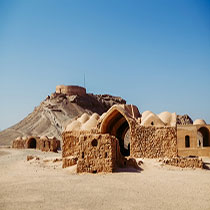Tower of Silence Iran
Dakhma is a type of structure used for funerary purposes by the followers of Zoroastrian religion that is located in the middle of the desert, also known as Tower of silence in Iran. In the Zoroastrian tradition, once a body ceases to live, it can immediately be contaminated by demons and made impure. The type of construction is not specified by the name. The common dakhma originally denoted any place for the dead.

Description
Yazd city was home to different religions throughout the centuries and as a result, many mosques, synagogues and Zoroastrian temples exist in Yazd. During Sassanid times, Yazd- that literally means God- became the center of Zoroastrians, as in time of conquering Iran by Arabs, many of them migrated to the city and settled down there.
The tower is located in the middle of the desert to defence of the wars. Tower of Silence is an 8-meter circular structure built on top of a hilltop in southeastern of Yazd and primarily was used for funerary purposes by adherents of the Zoroastrian faith. The roofless structure of the tower, or as the local people call it ‘Dakhmeh’, lets the birds of prey like vultures to dive in and out.
Architecture of Dakhma
Dakhmas were either built by humans or are naturally-created features of the earth. What is common between them is that they should have easy access for predators and they are outside the cities and villages. Thus, they don’t have any roof. They usually have a stone cylinder-shaped tower. In the Iranian Zoroastrian tradition, the towers were built in top of hills or low mountains in desert locations distant from population centers. Among Zoroastrian’s Dakhmas, two of them are more famous. First Mankeji Hutria Dakhma that is belonged to an Indian Zoroastrian and the second is Golestan Dakhma from Qajar Dynasty.
Zoroastrian belief
According to Zoroastrian belief, the four elements – fire, water, earth and air, are sacred, and ought not to be polluted by the disposal of the dead. Cremation, for example, is believed to cause pollution to fire, air, and at times river water as well, whilst burial causes pollution to the earth and ground water.